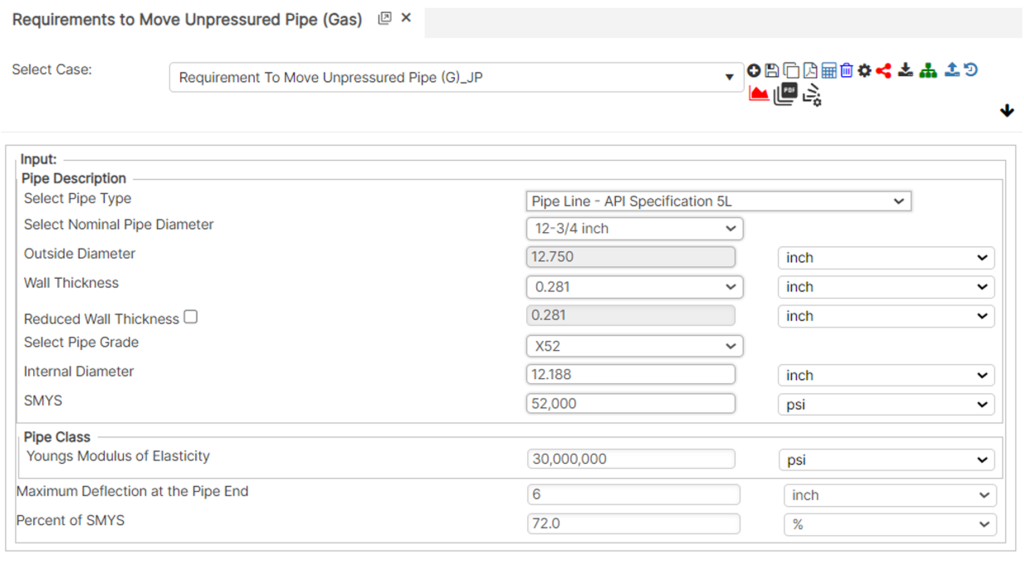Introduction
This application is related to maximum movement (deflection) at the end of pipe with no pressure. The greater the deflection requires a larger distance of exposed pipe to minimize the strain on the pipe.
S_{max}=\frac{(\%SMYS)}{100}(SMYS)\,[psia]
S_{max}=\frac{(\%SMYS)}{100}(SMYS)\,[psia]Where:
𝑆𝑚𝑎𝑥 − Maximum Stress Allowed
𝑆𝑀𝑌𝑆 − Specific Minimum Yield Strength
S_M=(\frac{\pi}{32})\frac{((D^4)-(D-2t)^4)}{D}\,[psia]
S_M=(\frac{\pi}{32})\frac{((D^4)-(D-2t)^4)}{D}\,[psia]𝑆𝑀 − Section Modulus
𝐷 − Nominal Outside Diameter (in)
𝑡 − Nominal Wall Thickness (in)
I=(\frac{\pi}{32})((D^4)-(D-2t)^4)
I=(\frac{\pi}{32})((D^4)-(D-2t)^4)𝐼 − Moment of Inertial
𝐷 − Nominal Outside Diameter (in)
𝑡 − Nominal Wall Thickness (in)
L_{en}=\frac{3L_dYI}{S_{max}S_M}
L_{en}=\frac{3L_dYI}{S_{max}S_M}𝐿𝑑 − Maximum Deflection at Pipe End(in)
𝑌 − Young′s Modulus of Elasticity (psia)
L_p=\frac{L_{en}}{12}
L_p=\frac{L_{en}}{12}𝐿𝑝 − Total Exposed Pipe Requirement (ft)
L_{max}=\frac{S_{max}S_M}{L_{en}}
L_{max}=\frac{S_{max}S_M}{L_{en}}𝐿𝑚𝑎𝑥 − Maximum Load at the Pipe End (lbs)
M=L_{max}(L_p)\,[lb/ft]
M=L_{max}(L_p)\,[lb/ft]Case Guide
Part 1: Create Case
- Select the Requirements to Move Unpressured Pipe application from the Design & Stress Analysis Module
- To create a new case, click the “Add Case” button
- Enter Case Name, Location, Date and any necessary notes.
- Fill out all required Parameters.
- Make sure the values you are inputting are in the correct units.
- Click the CALCULATE button to overview results.
Input Parameters
- Nominal Pipe Size (in): 0.625” – 48”)
- Wall Thickness (in): (0.068”- >2”)
- Pipe grade: (24000psi-80000psi) (if unknown use Grade A 24000)
- Maximum Deflection at the Pipe End (in)
- Percentage SMYS (%)

Part 2: Outputs/Reports
- If you need to modify an input parameter, click the CALCULATE button after the change.
- To SAVE, fill out all required case details then click the SAVE button.
- To rename an existing file, click the SAVE As button. Provide all case info then click SAVE.
- To generate a REPORT, click the REPORT button.
- The user may export the Case/Report by clicking the Export to Excel icon.
- To delete a case, click the DELETE icon near the top of the widget.
Results
- Maximum Stress Allowed (psi)
- Total Exposed Pipe Required (ft)
- Maximum Load at the Pipe Ends (lb)
- Section Modulus
- Moment of Inertia
- Moment (lbf-ft)


References
- ASME B31.8 – Gas Transmission and Distribution Piping Systems
- API 5L, API 5LS and API 5LX – Specification of Pipe Grade
- ASTM – Various – Weld Joint Factor
- CFR Code Part 192
- USDA-SCS Modified (Permissible Velocity of Water and Soil Erodibility)
- FHWA-HEC
- Pipeline Rules of Thumb Handbook
- Timoshenko, S – Theory of Elasticity Anchor Force
FAQ
-
Restrained versus Unrestrained Pipe (Difference in Gas vs. Liquid)?
ASME B31.4 liquid and B31.8 gas codes include calculations for the net longitudinal compressive stress that must be applied only for a restrained line that equates to a low (less than 2%) longitudinal strain. This stress status is characteristic to underground pipelines located some distance away from above ground piping facilities.
Unrestrained lines means those above ground sections of piping without axial restraint as with buried pipe with soil. In others words the soil exerts substantial axial restraint, but not fully restrained. Check Out
-
What is the Maximum Span Length of rev1?
Regarding span factors with and without water are based on bending stress and deflection. Larger diameter pipe spans require saddles for stability. Many standards that require pipes to be filled with water are based on bending and shear stresses not to exceed 1,500 psi and a deflection between supports not exceed 0.1 inches. Check Out
-
What is the model used for Thrust at Blow-Off?
